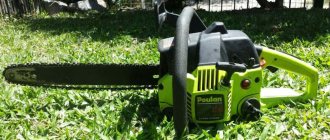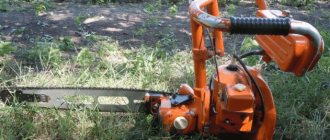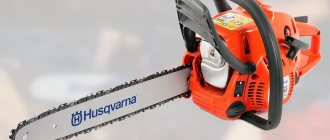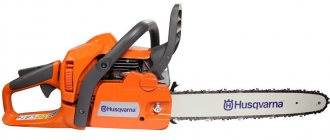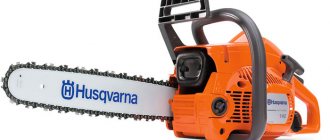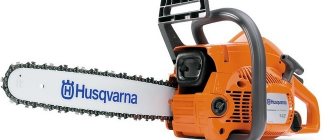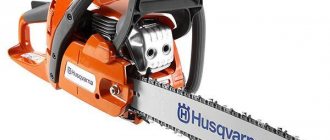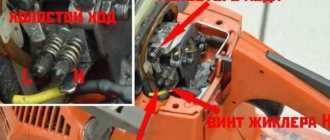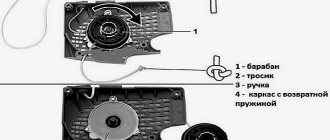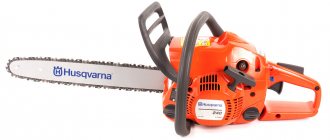How to adjust the carburetor of a Husqvarna 142 chainsaw
Adjusting the carburetor of the Husqvarna 142 chainsaw should be done when the engine is warm.
Pay attention to the condition of the air filter, which, if necessary, will need to be cleaned and make sure that it is not clogged. Adjusting the carburetor of the Husqvarna 142 chainsaw with your own hands is done using three screws:
- L – for low engine speeds.
- H – for high engine speeds.
- T – for idle speed.
Turn the low and high speed control screws clockwise to the limit, and after the peak is reached, turn them in the opposite direction, one and a half turns. When idling, the Husqvarna 142 chainsaw chain must be stationary. Check at maximum speed.
You can avoid most malfunctions and costly repairs by following the manufacturer’s instructions and recommendations, as well as using original spare parts for the Husqvarna 142 chainsaw.
The Husqvarna 142 gasoline saw is known to many users for its reliability, ease of operation, as well as the high quality of branded components and factory assembly. Garden tools in this modification quickly and efficiently cut down any wood, regardless of its condition and structure. This allows the model to be used not only for cleaning the garden, but also for the construction of domestic and utility premises.
Engine
Engine breakdown is one of the most common and time-consuming. This problem is manifested by the following factors:
- Unstable operation at idle.
- Does not start.
- There is not enough power, or the Husqvarna 142 chainsaw starts and stalls as soon as it starts to pick up speed.
Before you begin repairing the Husqvarna 142 chainsaw, it is recommended to conduct a complete diagnosis of the equipment to accurately determine the causes of the problems.
Chainsaw maintenance tips
To ensure that the saw does not shoot, does not sneeze, grips well when starting, serves for a long time and does not break, you must adhere to the following operating rules:
- Read the operating instructions carefully before turning on the chainsaw.
- Check chain tension. Here you need to reach a golden mean: the chain should not sag, but you also shouldn’t tighten it too much. The fuel mixture must be fresh and stored for no more than 2 weeks. Stick to the proportions when mixing oil and gasoline.
- You need to hold the saw confidently and levelly, while taking a comfortable position.
- Do not use for a long time without breaks.
- If the model is equipped with a primer, then pump the fuel before starting.
- Check the saw chain for sharpness. Avoid getting too dull. Follow the rules for sharpening cutting tools.
- After each use, the saw must be cleaned of sawdust and shavings. Select detergents individually.
- Follow the rules for storing your saw. Prepare it especially carefully for long-term storage.
Chainsaw doesn't start well when cold
Engine faults
CPG scuffing, ring sticking, CPG wear, air leaks through seals and gaskets, decreased compression, all these problems can make starting a chainsaw impossible or significantly complicate it. For example, if the CPG wear is not significant, the compression in the engine decreases. In this case, starting “cold” will be significantly difficult, or the saw may stop, the tool will start well.
It is quite difficult to accurately diagnose problems in the engine associated with problems in starting it, and it is better to contact a specialist in this field.
Violation of the sequence of actions when starting on a cold
If a new chainsaw does not start when cold, the reason may be the incorrect engine starting sequence. As a rule, each manufacturer, in the instructions for the chainsaw, indicates the procedure for starting the chainsaw when cold. Basically, it is similar for all two-stroke internal combustion engines that are installed on chainsaws, and represents the following procedure.
Closing the air damper (necessary to enrich the fuel during startup). Fuel suction using a special primer for this (on some models of chainsaws, the primer is not provided by the design, and therefore this item is not available for them)
Turning on the ignition (if you forget about this, you may mistakenly consider the tool to be faulty). Carry out several movements of the starter until the first “flash” of the engine (it is important not to miss this moment, otherwise it is possible to “flood” the engine). Set the air damper to the open position. Start the chainsaw engine.
Ignition coil
The reason that a new chainsaw does not start, or starts poorly, may be the ignition coil. Modern chainsaws are equipped with electronic ignition coils. This part cannot be repaired, and, as a rule, if there is a defect, it is completely replaced.
The lawn mower stalls when you press the gas, how to fix the problem
Reasons why a lawn mower stalls
– there can be a huge number, we offer the most common of them, and we hope that you will find yours and, of course, eliminate it. So, one of the situations is a clogged air damper, the hole behind which fuel is sprayed. If something gets into it, it can most often be quickly and easily removed. This is the simplest reason, just like a clogged filter. It needs to be washed in a solvent and then blown well with compressed air. If it cannot be repaired, then order a new one in spare parts from the KosiKosa store.
Likewise, when you press the gas, the tool stalls because the drive is clogged. The following option is also possible: fuel is not supplied in full, so you need to check or replace the fuel filter. Other possible reasons for a lawn mower stalling when you give it gas include:
- The crankshaft seals suck in air;
- The spacer that is located between the carburetor and the cylinder in a “problematic” situation;
To all these reasons why the mechanism stalls when adding gas, we will add some useful recommendations for handling the lawn mower. First of all, before starting to work with any equipment, you need to read the instructions. In this case, the consistency of gasoline and oil plays an important role, it is properly prepared by you, as well as not overheating the unit, and not leaving gasoline for the winter when you simply will not use the car.
In the full operation of any instrument, the coordinated work of all its components plays an important role. And if in one it is, then in the other it is a piston or a carburetor. Owners of brush cutters who want to use their tools to their full potential need to understand that under a load for which the machine’s capabilities are not designed, the entire mechanism or its individual parts may simply break. Therefore, only competent and moderate operation presupposes long-term effective operation of any gas-powered tool.
The trimmer stalls at idle - causes and solutions
Common situations why the trimmer stalls
or brushcutter, it is worth considering its operation at idle speed. Let's get straight to the reasons:
heating of the gearbox and a decrease in speed on the drum as a result of the fact that the gasoline solution is not prepared quite correctly. The required proportion is 1:4; carburetor contamination; the throttle valve is clogged; when the damper is opened (if such an experiment was carried out), the air flow makes the mixture “lean”; carburetor adjustment; air filter clogged;
An insufficient amount of fuel, which is needed for the operation of a gas-powered tool, will lead to a situation where at high speeds, when increasing, the trimmer works, but stalls at idle. In a situation with a carburetor, the device will stall on a cold start and on a hot start.
For any user of a lawn mower - professional or amateur - it is important to understand that any problem with the tool may depend on a minor part coming off, a fastener coming loose or clogging, as well as a global breakdown of an important part of the mechanism
A beginner and an experienced owner can encounter the problem of a stalled lawn mower; situations arise with used and completely new mowers, and we will look into which ones exactly in this article. So, the tool may stall under load, immediately after starting, that is, it starts and stalls when the entire mechanism heats up, at high speeds, or it does not even pick up speed and stalls. In all these cases, in fact, the same systems, elements, components are involved, but the breakdown or malfunction of each of them, more precisely, the nuances, cause the individual situation mentioned above. The answer to the question of every user: why does the lawn mower stall?
, you will receive only on our website in the news articles section.
To fully understand your individual situation, carefully read the signs and accompanying nuances when the scythe stalls, and then it will be easier for you to find a way out and quickly solve the problem. If you need certain ones, then you can do it wholesale and inexpensively at the best gas powered tools store in Ukraine, “Benzo Zip”.
Non-standard failures
If a normally operating chainsaw engine stalls when the tool is tilted to one side, you should open the gas tank cap and eliminate the freezing of the flexible fuel receiver.
Almost the entire range of Chinese chainsaws is, to a greater or lesser extent, copied from popular models of European origin, so the design differences are minor. The recommendations given can be used if a Chinese chainsaw fails.
The maintainability of Chinese chainsaw equipment has been increased due to the unification of the repair stock and the interchangeability of many components and parts with similar models.
There are several different reasons why a chainsaw will not start: the device may be faulty, there may be a lack of sufficient fuel, or problems with its supply. Often the problem can be fixed with your own hands. In some cases, specialist help may be required.
Why does the Shtil chainsaw not start when it's hot? Why does a chainsaw have trouble starting?
Main reasons:
- fuel and air filters;
- reduced compression;
- carburetor adjustment;
- spark plug;
- ignition coil;
- gap between the ignition coil and the flywheel;
Let's look at each reason in more detail.
Fuel and air filter
Contamination of the main filter elements of a chainsaw negatively affects its operation.
For example, a dirty air filter will not provide enough air to the carburetor, which will affect the quality of the air-fuel mixture and normal engine starting. A dirty fuel filter will make it difficult or even cut off the flow of gasoline to the carburetor and make it impossible for the engine to operate.
Reduced compression
One of the common cases of difficult starting of a chainsaw is wear of the CPG (cylinder-piston group).
As you know, for a chainsaw to start normally, compression must be present in its engine. It is necessary for normal compression of the fuel mixture in the engine cylinder, and it also affects the operation of the fuel pump.
During the operation of the tool, the compression value drops and the chainsaw begins to have difficulty starting.
The reasons for the lack of compression or its decrease may be natural, because The engine wears out during operation. Problems can also be caused by a serious breakdown, for example, a scuffed CPG, or a broken piston ring.
A sign of low compression is weak starter resistance when starting. With reduced compression, a decrease in the power of the chainsaw is observed, which negatively affects its performance. The problem is eliminated by replacing the piston rings, or the entire CPG.
Carburetor adjustment
Incorrect carburetor adjustment will cause the chainsaw to not develop full power. It will be difficult to start, or not start at all. Carburetor settings directly affect the quality of the air-fuel mixture, which is necessary for normal starting and further operation of the engine.
If the carburetor is incorrectly adjusted, there will be more or less gasoline in the fuel-air mixture than required, and the mixture will not ignite even with normal sparking.
Excess gasoline in the mixture is usually called overflow. A characteristic sign of overflow is a wet spark plug, after several unsuccessful attempts to start the chainsaw.
Spark plug
The spark plug is one of the main elements of the ignition system. A spark is formed at its electrodes, and if this element fails, starting will be difficult or not possible at all.
The spark plug may fail completely, or work intermittently or produce a weak spark. Checking the spark plug is quite simple; to do this, you need to unscrew it from the engine, attach it to the cap of the high-voltage wire and, placing it on the cylinder, pull the starter. If the spark plug is in order, the spark will be powerful with a bluish tint. A weak spark with a reddish tint is a sign of a problem. A defective spark plug needs to be replaced.
Ignition coil
The reason that a new chainsaw does not start, or starts poorly, may be the ignition coil. Modern chainsaws are equipped with electronic ignition coils. This part cannot be repaired, and, as a rule, if there is a defect, it is completely replaced.
Gap between ignition coil and flywheel
An incorrectly set gap between the flywheel and the ignition coil contacts affects the quality of spark formation, which in turn is responsible for normal starting and stable operation of the engine.
Benefits of DIY repairs
Experts offer several search options - the reasons for poor engine starting or if the power unit stalls during operation. The recommendations are equally valid for household and professional-grade chainsaws.
Owners with experience in operating chainsaw equipment use simple, time-tested, intuitive troubleshooting algorithms, which allows them to quickly eliminate many failures and breakdowns directly during operation.
The success of the work is facilitated by knowledge of the design of the tool and the interaction of all its components, the presence of plumbing and repair skills and operational experience. These same abilities allow owners to use their chainsaw equipment with high efficiency.
Self-repair provides the opportunity to significantly save material resources and reduce forced downtime.
If the chainsaw doesn’t start, what should you do?
The main reasons why a chainsaw does not start are discussed above. Moreover, this applies to instruments of different brands: Shtil, Husqvarna, Partner, Makita, Champion and others. Druzhba chainsaws have a different operating principle, but in general, troubleshooting should begin with the ignition system, or rather, inspecting the condition of the spark plug electrodes. If the manipulations carried out do not help to obtain the desired result, then it is necessary to resort to more serious actions. This means you need to do the following:
- Check the serviceability of the carburetor and adjust it
- Measure the compression level of the engine, and then draw the appropriate conclusion about its serviceability
- Checking compression in the crankcase
Checking the compression in the cylinder allows you to assess the condition and serviceability of the CPG
. To measure compression you will need a compression meter. It is screwed into the spark plug hole, after which the starter handle is pulled. The compression gauge shows the corresponding pressure value in the cylinder. This value should be at the level of 8-12 atmospheres.
If the pressure is significantly lower, then this is a direct sign of a malfunction of the device. In case of malfunction, the cylinder-piston group is replaced with a new one. When installing a new CPG, it is necessary to carefully treat all parts with oil so that chips and scuffs do not form when the engine starts.
If there is no compression in the crankcase, the chainsaw will also not start.
The reason for the decrease in pressure in the crankcase is the gasket, or rather its damage. This gasket is located between the cylinder and the crankcase and to ensure its serviceability, the following manipulations should be performed:
- Disconnect the fuel line from the tank
- Place the tube in a container with a prepared mixture of gasoline and oil.
- Start the chainsaw engine
- If the engine starts and fuel is sucked in, this indicates that the gasket is in good condition.
If fuel is not drawn in, then the crankcase gasket needs to be replaced.
The carburetor is the most important and most complex element of a chainsaw.
If all the above steps did not help to obtain a positive result, then this indicates that the carburetor is faulty. The main malfunction of the carburetor is clogging of its channels and jets. Membranes and other elements fail less often. In any case, you will need to disassemble the chainsaw carburetor, clean it and replace failed parts.
As you can see, there are enough reasons why a chainsaw won’t start. To find out what exactly happened in your case, you need to remember the symptoms the day before. Perhaps before the chainsaw stopped starting, there were malfunctions in the engine, a decrease in power and performance, and other breakdowns were also present. Based on these technical symptoms, it is necessary to begin the search. If you don’t know where to start, then diagnostics should be carried out in order, as described in the material.
Checking the carburetor and signs that it needs adjustment
The rated engine power and savings in fuel consumption depend on the good condition of the carburetor. The carburetor of a chainsaw has no functional difference from a car. It mixes gasoline vapors with air entering through the pipe and delivers them further into the combustion chamber.
Carburetor design
It consists of:
- air duct or tube for air supply;
- fuel line or fuel supply tube for mixing it with air;
- air damper.
A sign that the carburetor needs to be adjusted:
- strong vibrations due to unbalanced screws. An engine with a working carburetor runs smoothly and sounds like a four-stroke stroke;
- damage to the protection cap;
- wear of the piston system, which already requires a different mixture in composition;
- involuntary engine shutdown, inability to restart or initially start;
- an unreasonable increase in gasoline consumption, while engine power may remain the same, but most often decrease;
Actions if a malfunction is detected in various parts of the unit
Such unpleasant phenomena as loss of power, lack of connection, and idle support are common. The reasons for this behavior of the tool are malfunctions of the chainsaw carburetor. This is expressed in contamination with particles of dust and sawdust. Such a breakdown can be easily repaired on its own.
The carburetor is cleaned using:
- a small amount of gasoline;
- Phillips screwdriver;
- brushes;
- heads, size 8.
To begin repairing the carburetor, they begin by cleaning it from dirt and dust particles and small wood. A brush is used for this. When the surface is completely free of debris, the repairman removes the cover, and then the filter.
The air collector is released after unscrewing the air filter mounts. The user now has access to the accelerator and rods. The accelerator lever is removed as soon as the throttle is lowered by pressing down with your finger.
The carburetor moves away from its seat after the choke lever is removed and closed. Then the wire is removed and pulled towards itself to stop the engine. The plastic lever, which is the place where the wire is attached, is photographed.
It is raised from the left. As a result, the carburetor is freed, which makes it possible to pull it out and clean it. For these purposes, it is convenient to use a compressor. In its absence, the parts are washed in clean gasoline.
Disassembling a Stihl chainsaw – video
Important! When repairing a poorly functioning Stil MS 180, be sure to inspect the condition of the fuel filter. Remove it and blow out the fuel hose
The saw carburetor assembly process is carried out in reverse order. If, after this process, smoke appears from the muffler and the saw engine does not start well, then you need to make sure that there is a spring located under the lever needle.
The spring cuts off the fuel supply. In its absence, a spontaneous “overflow” of fuel into the spark plug occurs.
It is important to ensure that the spring is installed in its place and make sure that the spark plug is working
If a candle is filled with gasoline, it should be dried. To do this, the part is unscrewed and the excess fuel that gets inside is drained through the existing hole. The candle takes more than half an hour to dry. Then it is installed in place, and the chainsaw is brought into working condition.
Insufficient contact between the high-voltage wire and the end of the spark plug can also be one of the reasons for tool failure. Repair of stihl chainsaw parts can be done by replacing problematic parts.
For example, if a spark plug fails, it is replaced with a reliable one. Chains, sprockets, and tires are subject to rapid wear. They solve anti-vibration problems in the chainsaw device, so they are replaced urgently. It is recommended to keep such spare parts in stock.
How filters work
The next most popular cause of saw malfunction is clogged filters. The cutting tool consists of two filters - air and fuel. These parts are responsible for different processes, but equally contribute to cleansing and trap foreign particles.
Fuel filter
Checking the operation of the fuel filter is carried out as follows:
- The fuel supply channel is disconnected from the carburetor.
- Gasoline is being pumped.
- The supply of fuel is monitored.
- If gasoline flows under low pressure (or does not flow at all), then the conclusion is made that the fuel filter is clogged.
- All gasoline is removed from the tank.
- The filter element is detached using a hook.
- The replacement cartridge is being cleaned. If desired, you can skip this step and replace the clogged filter with a new one.
- The saw is going back.
Filters tend to become dirty over time. Therefore, experienced chainsaw owners clean filters as a preventative measure. The frequency of this procedure depends on the conditions in which the master works. If there is a lot of dust in the workshop, the cartridges become dirty faster.
Air filter
As a result of a clogged air filter, the saw engine begins to operate unstably. In practice, this factor leads to periodic switching off of the saw or difficulties with starting. The absorbent material accumulates dust and dirt, a large volume of which leads to complete obstruction of the membrane. When air stops flowing into the system, the gasoline becomes too rich.
The air filter is cleaned according to a similar scheme:
- The chainsaw is opened and the air filter is removed.
- Removing the filter prevents dust particles from entering the carburetor.
- The cartridge is disconnected and cleaned of accumulated dirt.
- The surface of the filter is treated with washing liquid.
- The element is thoroughly dried.
- The saw is going back.
Breather
